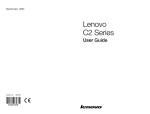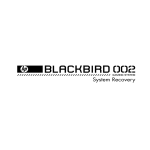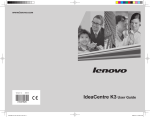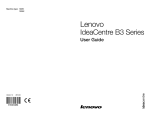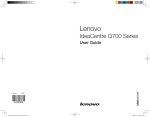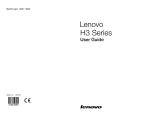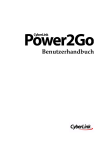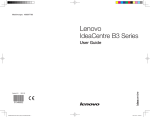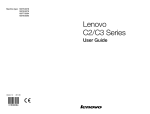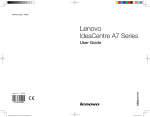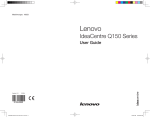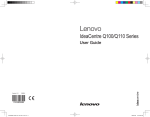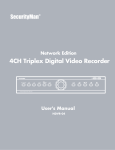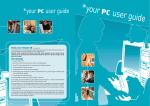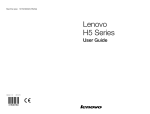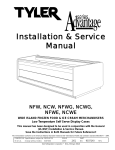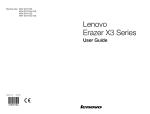Download Lenovo C310 User's Manual
Transcript
C310/C315 Series User Guide Version 1.0 2010.01 31041659 Important Safety Information Before using this manual, it is important that you read and understand all of the related safety information for this product. Refer to the Safety and Warranty Guide that you received with this product for the latest safety information. Reading and understanding this safety information reduces the risk of personal injury or damage to your product. Danger: Be aware of extremely hazardous or lethal situations. Attention: Be aware of possible damage to programs, devices, or data. Note: Pay attention to this important information. © Copyright Lenovo 2010. Contents Important Safety Information Chapter 1 Using the Computer Hardware............................... 1 1.1Front view.................................................................................2 1.2Left and right view of the computer..........................................3 1.3Rear view of the computer........................................................4 1.4Computer stand ......................................................................5 1.5Connecting your computer.......................................................6 1.6Important information about using the computer....................10 1.7Keyboard and Mouse (wired)..................................................12 1.8Using the Remote Control......................................................13 Chapter 2 Lenovo Touch Control Software Operating Instructions............................................................. 17 2.1Startup and Configuration.......................................................18 2.2Lenovo Touch screen User Gesture Instructions.....................24 2.3Precautions when using Lenovo Touch...................................32 Chapter 3 Using the Rescue System..................................... 35 3.1OneKey Recovery...................................................................36 3.2Driver and Application Installation...........................................36 3.3System Setup.........................................................................37 3.4System Backup......................................................................38 3.5System Recovery...................................................................38 3.6Create Recovery Disc.............................................................38 Chapter 4 Using the Computer Software.............................. 39 4.1Power2Go — Burning Discs . ................................................40 4.2McAfee Security Center..........................................................41 Contents 1 Chapter 5 System Maintenance and Recovery..................... 43 5.1Restoring the System.............................................................44 5.2Backup and Restore...............................................................44 5.3Cleaning Up the Disk..............................................................44 5.4Checking For, and Correcting Disk Errors...............................45 5.5Defragmenting the Disk(s).......................................................45 5.6Performing Daily Maintenance Tasks.......................................45 Chapter 6 Troubleshooting and Confirming Setup............... 47 6.1Troubleshooting Display Problems..........................................48 6.2Troubleshooting Audio Problems............................................49 6.3Troubleshooting Software Problems.......................................49 6.4Troubleshooting Problems with Optical Drives and Hard Disks..............................................................................50 6.5Special considerations for troubleshooting Windows..............51 2 Contents Chapter Using the Computer Hardware This chapter contains the following topics: 1 2 Computer hardware introduction Information on computer connections Note: The descriptions in this chapter might vary from your computer, depending on computer models and configurations. 3 4 5 6 User Guide 1 1.1Front view Volume down Volume up Brightness down Brightness up LCD On/Off Power button 2 User Guide 1.2Left and right view of the computer Attention: Be sure not to block any air vents on the computer. Blocked air vents may cause thermal problems. 1 2 Memory card reader 3 Optical drive slot USB ports (2) User Guide 3 1.3Rear view of the computer 6 7 8 1 2 3 4 5 4 Power connector USB ports (Some models have 4 USB ports) TV tuner (Select models only) IEEE 1394 connector PS/2 keyboard connector Headphone connector Ethernet connector Microphone connector User Guide 1.4Computer stand 12° min. 40° max. Use the stand to position the display to your preference. It can be rotated between12º and 40º from the vertical. The stand provides stability to the computer; it is not a removable part. Attention: 1. The computer stand must remain installed at all times to ensure maximum system stability. 2. Make sure the angle of the computer is at least 12 degrees from the vertical; otherwise the computer will be unstable and could fall over. To open the computer stand, do the following: User Guide 5 1.5Connecting your computer Use the following information to connect your computer: • Look for the small connector icons on the back of your computer. Match the connectors to the icons. Note: Your computer might not have all of the connectors that are described in this section. 1.5.1Check the voltage rating before you connect the equipment to an electrical outlet to ensure that the required voltage and frequency match the available power source. If your computer uses an AC adapter: Note: Use only the Lenovo provided AC adapter approved for use with this device. Use of another AC adapter may cause a fire or explosion. 1.5.2Connect the keyboard cable to the appropriate keyboard connector (PS2 connector or USB connector). 1.5.3Connect the mouse cable to the appropriate mouse connector (USB connector). 6 User Guide 1.5.4If you have audio devices, attach them using the following instructions: 1 2 Microphone Use this connector to attach a microphone (purchased separately) to your computer when you want to record sound or if you use speech-recognition software. Headphone Use this connector to attach headphones (purchased separately) to your computer when you want to listen to music or other sounds without disturbing anyone. 1.5.5If you have powered speakers with an adapter: (This picture is only a sketch print, it does not show the actual figure of the speaker) a. Connect the cable that runs between the speakers if necessary. On some speakers, this cable is permanently attached. b. Connect the adapter cable to the speaker if necessary. On some speakers, this cable is permanently attached. c. Connect the speakers to the Headphone port on the computer. d. Connect the adapter to the power source. User Guide 7 1.5.6If you have powered speakers without an adapter: (This picture is only a sketch print, it does not show the actual figure of the speaker) a. Connect the cable that runs between the speakers if necessary. On some speakers, this cable is permanently attached. b. Connect the cable to the speaker if necessary. On some speakers, this cable is permanently attached. c. Connect the speakers to the Headphone port on the computer. d. Connect the plug to the power source. Note: Some models are not equipped with external speakers. 1.5.7Connect any additional devices that you have. Your computer might not have all connectors shown. 1 2 3 4 1394 USB connector Use this connector to attach a device that requires a USB connection. Network adapter Use this connector to attach the computer to an connector ethernet-type local area network IEEE 1394 8 User Guide This connector provides connection to several types of consumer electronics including digital audio devices and scanners. TV-Tuner connector Only supported on systems with optional TV tuner card. 1.5.8Connect the power cords properly to grounded electrical outlets. 1. Plug the power adapter cord into the back of the computer. 2. Plug the power cord into the AC adapter. 3. Plug the power cord into an AC power source. 1.5.9If your computer is equipped with a Memory Card Reader Connector, it is able to read/write data from: MS/MS pro/xD/SD/SD pro/MMC User Guide 9 1.6Important information about using the computer Press the power button which is located on the bottom right of the screen to turn on the computer. Note: The LCD ON/OFF indicator will be light when you press the button. If you press the wrong button, the screen might be turned off. Then you need to turn on the screen again. 10 User Guide Hold the computer tightly when you carry it. User Guide 11 1.7Keyboard and Mouse (wired) LV T ——Volume down ——Volume up ——Mute LVT ——After starting the Windows operating system, press the LVT key to start the program. You can then learn to use this featured software designed for the Lenovo home PC with integrated Lenovo core technology, and you can also use any other installed programs on the computer. Notes: • Some models are not equipped with the LVT program. • The LVT key on the keyboard is disabled in the models without the LVT program. F2 ——Your computer has the Lenovo Rescue System installed. To learn more about this program, turn on the computer, and when the Lenovo logo appears, press the F2 key and the Lenovo Rescue System will open. 12 User Guide 1.8Using the Remote Control (Only some models are equipped with remote control). The remote control (only shipped with some types of computers) works with the remote control receiver on the chassis. Adjust the angle of the remote control properly. User Guide 13 Buttons on the remote control: Button Description Up Down Left Right OK Confirm Back Details Guide (This function is not available in Microsoft Windows operating systems.) Shows live TV on the currently selected channel. Displays the Recorded TV page in Windows Media Center. Play Pause Stop Record Fast Forward Rewind Skip Replay 14 User Guide Starts Windows Media Center. Turns volume up/down Previous/next channel Mute DVD menu Power supply (standby) 0~9 Number (or Letter) buttons # key * key CLEAR Clear ENTER Enter Teletext ON/OFF (Selected models only) Red, Green, Yellow, Blue (Selected models only) User Guide 15 16 User Guide Chapter Lenovo Touch Control Software Operating Instructions This chapter contains the following topics: Startup and Configuration Lenovo Touch screen User Gesture Instructions Precautions when using Lenovo Touch 1 2 3 4 5 6 User Guide 17 Introduction to the Software: Lenovo Touch Control is the user control software for the Lenovo Touch screen. It can be used to perform common touch control tasks you need to operate the computer, such as enabling/disabling or calibrating the touch screen. The monitor is installed with a touch screen and is touch-sensative. The touch screen, just like a mouse or a keyboard, is an input device, through which the user’s hand can transmit coordinate information to the computer. Utilizing this technology allows the user to operate the computer by gently touching the pictures or words on the computer screen with your fingers. 2.1Startup and Configuration 2.1.1Enabling/Disabling the Touch Screen Lenovo Touch Control software by default is pre-installed in the computer operating system. After starting up Windows: 1. In the notification area of the taskbar at the bottom of the screen, click the Lenovo Touch Control icon. 2. In the pop-up window click “Enable Touch” to enable the touch function. 18 User Guide 3. If you need to disable the touch function, repeat Step 1, and click “Disable Touch”. Attention: If the Lenovo Touch Control icon is not shown in the notification area of the taskbar, please click: Start → All Programs → Lenovo → LenovoTouch → Lenovo Touch Control, and then the Lenovo Touch Control icon will appear in the notification area of the taskbar. User Guide 19 2.1.2Calibrating the Touch Screen When the touch screen reacts in a different place from where you are touching it, or it stops reacting, please follow the steps below to calibrate it: 1. In the notification area of the taskbar at the bottom of the screen, click on the Lenovo Touch Control icon, and in the pop-up window select “Configuration”. 2. In the “Lenovo Touch Control” window, click the “Adjustment Tool” button. 20 User Guide 3. When the calibration screen appears, use your finger to touch each of the 4 calibration points that are shown in sequence. After finishing these operations, the calibration screen will disappear, and the screen calibration is complete. Please touch the target point shown on the display. Attention: While in use, whenever the touch screen reacts in a different place from where you are touching it, or it stops reacting, just start the calibration program. User Guide 21 2.1.3Automatically enable touch at startup If you want the touch screen to launch automatically when the computer starts up, please follow the steps below: 1. In the notification area of the taskbar at the bottom of the screen, click on the Lenovo Touch Control icon, and in the pop-up window select “Configuration”. 2. In the “Lenovo Touch Control” window, check the “Automatically enable touch at startup” box, and then close this window. 3. If you do not wish to enable this function at start-up, uncheck the “Automatically enable touch at startup” box. Attention: All configurations will take effect after the computer is restarted. 22 User Guide 2.1.4Reset Default Setting If you wish to reset the touch function to its default setting, please follow the steps below: 1. In the notification area of the taskbar at the bottom of the screen, click the Lenovo Touch Control icon, and in the pop-up window select “Configuration”. 2. In the “Lenovo Touch Control” window, click the “Reset Default Setting” button, and when the pop-up dialogue box prompts that “The default setting has been restored!”, click “OK” to finish the operation. User Guide 23 2.2Lenovo Touch screen User Gesture Instructions The Lenovo Touch screen supports single touch, as well as multi-touch, like rotation, zoom in and zoom out. The user can transmit coordinate information to the computer by touching the screen. The touch screen uses a pressureless touchrecognition method, which, in order for you to operate the main computer, only requires you to gently touch the items on the screen with your fingers or make a simple hand gesture. 2.2.1Basic Hand Gestures 1. Single Click/Double Click For the desired item on the touch screen, use one finger to touch it very gently one or two times, thereby performing the single click or double click operation. This is similar to the action of clicking the left mouse button. 24 User Guide 2. Single-Finger Right Click For the desired item on the touch screen, press and hold your finger on the screen until a circle appears. After lifting your finger from the touch screen, a menu bar will pop up. Through these steps you perform the single-finger right click operation. This is similar to the action of clicking the right mouse button. User Guide 25 3. Double-Finger Right Click First use Finger 1 to point the desired item and hold it there, then use Finger 2 to touch anywhere nearby on the screen and quickly lift it up again. Through these steps you perform the double-finger right click operation. The area where Finger 1 is placed can be used to show the right-click menu or perform related operations. 1 2 4. Dragging Movement First use your finger to touch the desired item on the screen and hold it there, then make a dragging movement. This is similar to the click and drag movement you can make with a mouse. 26 User Guide 5. High Speed Slide If you touch the screen with a single finger and slide for a short distance horizontally (about 5 cm), and then quickly lift your finger up again, this is called a High Speed Slide, and the screen will show the “Forward” or “Back” icon. Under the default settings, a high speed horizontal sliding movement can achieve a forward or back operation, such as the Forward and Back operations in the IE browser; or Previous and Next slide operations in the slideshow mode of Windows Photo Viewer. about 5 FP 6. Rolling Movement When you move your finger vertically (or horizontally) on the touch screen, this is called a Rolling Operation. This operation is similar to moving the scroll bar with a mouse, and produces the same results as the scroll bar interface. User Guide 27 7. Zoom Operation Use two fingers to gently touch the desired item on the touch screen, and while keep touching the screen, slide to change the distance between your two fingers. By increasing (or decreasing) the distance, you can perform a zoom in (or zoom out) operation. For example, you can enlarge or reduce the picture size in Windows Photo Viewer. 8. Rotation Operation Use two fingers to lightly touch the desired item on the touch screen, then rotate in the desired direction. For example, you can rotate the picture which is being displayed in Windows Photo Viewer. 28 User Guide 2.2.2Touch Screen Related Settings 1. Flicks: In the notification area of the taskbar at the bottom of the screen, click the Flicks icon, and the current Flicks window will appear. click anywhere in this window to enter Flicks Training. The user can perform operations according to the advice given on the screen. 2. For more detailed configurations, you can click the Flicks icon in the notification area of the taskbar at the bottom of the screen, then click “Customize your flicks setting” in the Flicks pop-up window. In the “Pen and Touch” window, the user can adjust more settings related to “Pen and Touch” according to their specific preferences. User Guide 29 On the Flicks tab you can: • Select commonly used Flicks operation groups • Adjust the sensitivity of the touch screen 30 User Guide On the Touch tab you can: • Enable / disable options such as “Use your finger as an input device” and “Enable multi-touch gestures and inking”. • Select touch actions which you wish to adjust. By clicking “Settings”, you can adjust the “Speed” and “Spatial Tolerance” parameters, to match the user’s natural way of double-clicking. You can double-click the image on the lower right corner to test this. • Enable / disable touch points. Notes: Users can obtain more help information from the “Help and Support” menu in Windows. User Guide 31 2.3Precautions when using Lenovo Touch 1. With the new touch recognition technology of Lenovo Touch, the user only needs to gently tap on the touch screen, and does not need to exert any pressure to complete operations. When using it please remember not to use excessive force or tear the screen surface with any sharp object. 2. In order to ensure normal use, you should remove any dirt from the touch screen, and ensure your fingers are clean and dry, and avoid using it in dusty environments, or in very hot or humid conditions. 3. The product case is easy to clean. To ensure safety, please clean the screen and frame with a soft cloth after turning the computer off. Note that when wiping the screen, wipe it from top to bottom, and do not wipe upwards. 4. Remove in time any dust accumulated in the four corners of the screen and the bottom of the screen frame, so as to prevent accumulated dust from interfering the touching and positioning function of the screen. Do not place or drop any obstructive object in the four corners of the screen or any part of its frame, so as to prevent the screen from being unable to locate positions due to obstruction. 5. This touch screen is supplied with related configuration software, which will consume a reasonable amount of CPU resources when the touch screen is in use. Notes: When it is used in a normal way, the touch operations will not affect the execution of other computer processes. 32 User Guide 6. The recognition of touch gestures by this product can be influenced by the following factors: • Touching the correct place on the screen • The speed of movement • The elapsed time since the screen was touched last time • The recognition rate of two-finger operations Notes: To learn accurate hand gesture operations, the user can consult this manual and also the related Windows help. 7. In order to achieve a better degree of touch screen sensitivity, the user should avoid placing the screen too close to an artificial light source or in the direct path of strong sunlight. 8. The touch screen does not function in Rescue System mode. 9. The touch screen also does not function during the startup process, or in Sleep mode or Safe mode. User Guide 33 34 User Guide Chapter Using the Rescue System This chapter contains the following topics: OneKey Recovery Driver and Application Installation System Setup System Backup System Recovery Create Recovery Disc 1 2 Attention: Using this program will result in a loss of data. • You can recover the C drive of the computer to the factory default settings or to the last system backup status using OneKey Recovery. With this operation, all of the existing data on drive C will be lost, whereas the content and format of the other partitions of the hard disk drive will remain unchanged. 3 4 5 • If you want to install an operating system and back it up with OneKey Recovery, you must format the C partition in NTFS format and install the operating system on the C partition. Otherwise, the OneKey Recovery system cannot run. 6 User Guide 35 Note about the service partition: The files and relevant data used by the rescue system are saved in the service partition. Deleting this partition will make the rescue system unusable. For more detailed information, see the following instructions: By selecting Control Panel → Administrative Tools → Computer Management → Disk Management, you can see the service partition, which must not be deleted. Note: The recovery files and relevant data used by the rescue system are saved in the service partition. If the service partition is deleted or damaged by someone other than authorized Lenovo servicers, Lenovo will not be liable for any losses arising there from in any way. 3.1OneKey Recovery OneKey Recovery is an easy-to use application. You can use it to restore your computer to the system default or a previously backed up state. Detailed Operation Procedure 1. Turn on the computer. When the Lenovo logo appears, press the F2 key on the keyboard to start the Rescue System, then you can select OneKey Recovery. Note: System Recovery will overwrite all of the data on drive C. To prevent loss of data, be sure to back up relevant data before performing system recovery. 2. Follow the onscreen instructions to select the backup task you want to restore from and disk you want to install operation system, and press Next to start restoration. 3. Please wait during the process of system recovery. Do not interrupt the operation during the recovery process. 4. After the system is recovered successfully, the software prompts to restart the computer. Restart the computer and enter the system. 3.2Driver and Application Installation The Driver and Application Installation function in the rescue system provides a way for the user to conveniently re-install all of the Lenovo applications and drivers that were shipped with your Lenovo hardware. 36 User Guide Method 1: Automatic Installation Turn on the computer. When the Lenovo logo appears, press the F2 key on the keyboard to start the Rescue System, then select Drivers and Application Installation. Follow the screen prompts to install the Lenovo Drivers and Application Installation. Click Install to start installing the Lenovo Drivers and Application Installation. The system will restart. After the system has restarted, the installation process will continue until completion. Method 2: Manual Installation In the Windows system, Click Start → All Programs → Lenovo → Lenovo Drivers and Application Installation. After starting the procedure, install all the drivers and software manually according to the prompts. Notes: 1. It is recommended not to install the software which is already on the computer. 2. Before accessing the operating system, make sure that the Drivers and Application installation has been installed automatically. After that, the manual installation function can be used. 3.3System Setup System Setup configures the network configuration for the Lenovo Rescue System to ensure your Rescue System can connect to internet. In addition, System Setup sets and manages all passwords for the Lenovo Rescue system. 3.3.1Launch Turn on the computer. When the Lenovo logo appears, press the F2 key to launch Rescue System. Then select System Setup. 3.3.2Network Settings Depending on the network access mode of the computer, select “ADSL” or “LAN Connection” in the network connection modes. 1. If you select “ADSL,” input the username and password of the ADSL connection. User Guide 37 2. If you select “LAN connection,” configure the IP address and proxy server of the LAN. 3.3.3Password Management Password Management allows you to set the password for Lenovo Rescue System and manage it. The default password is blank. Set a password when you access the Password Management for the first time. If you don’t want to set a password, access the system directly and operate accordingly. 3.4System Backup Back up your system partition to an image file. In case of a system failure, you can restore your system from this image file. In the Windows system, click Start → All Programs → Lenovo → Lenovo Rescue System. After starting the procedure, click System Backup to back up your system partition according to the prompts. 3.5System Recovery Reboot your computer into the system recovery environment. You can choose to restore to a system backup point or the initial state. 3.6Create Recovery Disc Create a bootable recovery disc from current system. These recovery discs are used to boot your computer and will guide you through the entire restoration process. In the Windows system, click Start → All Programs → Lenovo → Lenovo Rescue System. After starting the procedure, click Create Recovery Disc to create a bootable recovery disc from current system. Follow the screen prompts to create recovery discs. 38 User Guide Chapter Using the Computer Software This chapter contains the following topics: Computer software instructions Note: The interface and function of each of these features are subject to the actual software that was shipped with the computer model that you purchased. 1 2 3 4 5 6 User Guide 39 4.1Power2Go — Burning Discs (This software can only be used on models with a rewritable optical drive) Power2Go is the software for disc burning. It provides various burning tools that enable you to easily store your files into CDs or DVDs. Power2Go can make common data discs, music discs, video/photo discs and mixed discs. It also supports disc duplication. Note: This software does not support the burning of VCD audio or Blu-ray disk DVDs. 4.1.1Launch 1. Choose All Programs → Lenovo → Power2Go → Power2GoExpress from the Start menu to launch the burner program. 2. The shortcut to launch the burner software is the block icon on the desktop. To use the burner program, just drag and drop the files to be recorded onto their appropriate data, music, or video icon. 4.1.2Starting the Burner Software 1. Choose All Programs → Lenovo → Power2Go → Power2Go from the Start menu to launch the burner program. 2. Choose a task for the burner from the task list. Then start the burner to record files. 3. You can choose the medium to burn from the disc type, and then click the OK icon to access the burner interface. 4. Select the file to be burned from the select source box, and then click the add files icon to add your files into the disc compilation column. Click the burn icon to start burning process. 4.1.3Disc Utility The burner also provides utility tools for preparing and processing various CDs and DVDs, such as the recording of mirror files, erasing of discs, and conversion of audio. 4.1.4Help For more information about the use of Power2Go, click the Help icon. 40 User Guide 4.2McAfee Security Center McAfee VirusScan Center offers proactive PC security to prevent malicious attacks. It also provides security against multi-pronged attacks by combining anti-virus, anti-spyware and firewall technologies. Note: Connect to the Internet before activation. 4.2.1Using McAfee Security Center Choose All Programs → McAfee → McAfee Security Center from the Start menu to launch the antivirus software. Or, Double click the McAfee Security Center on the desktop to launch the antivirus software. 4.2.2Scanning for Viruses Click Scan on the Security Center home page. Select a task on the Scan Options pane, Click Start to launch the scan program. Upon completion, the software will pop up a system scanning report, which lists all virus files detected, and you can then quarantine or delete them as required. 4.2.3Check for updates Click Update on the Security Center home page to check for updates. Note: Connect to the Internet before upgrading. 4.2.4Help and Support For more information on the operation of Security Center, see product help Information in the Help option. In the help document, you can learn more about McAfee Security Center operation and settings. User Guide 41 42 User Guide Chapter System Maintenance and Recovery This chapter contains the following topics: Daily Maintenance and Tools Instructions 1 2 3 4 5 6 User Guide 43 5.1Restoring the System The system can develop problems due to erroneous operation or the installation of additional software. If software problems develop in the originally installed software, you can restore the system by using system backup and restoration features. Note: The existing system settings will change after restoration. Check the settings of the restored system to ensure they match settings that may be critical to your needs. Use the following procedure to restore the software to a known functional level: 1. Click Start → All Programs → Accessories → System Tools → System Restore. 2. Choose either the recommended restore point, or select a different recovery time from the pop-up box. Choose the latest date when the system was running properly. Click Next to continue. 3. The system will start restoration. When all processes run to completion, the system displays a message informing you that the restore operation has completed successfully. 5.2Backup and Restore For security purposes, you can back up the system status before you install additional software, or otherwise modify system settings. To back up the system status, do the following: 1. Click Start → All Programs → Maintenance → Backup and Restore. 2. Select the location for your backup. Click Next and follow the instructions to continue. 5.3Cleaning Up the Disk Do the following periodically to clean up the disks and possibly enhance your computer’s performance: 1. Click Start → All Programs → Accessories → System Tools → Disk Cleanup. 2. Choose the disk you want to clean up. 3. Click the OK button to start the cleanup process. 44 User Guide 5.4Checking For, and Correcting Disk Errors To properly maintain your system, you should periodically check for and fix hard disk errors by doing the following: 1. Right-click the icon for the hard disk drive (HDD) that you want to reorganize, then select Properties from the pop-up menu. 2. Select the Tools tab, and then click Check Now. 3. Check your inspection items for the disk and click Start. Note: You cannot start error checking until the computer is restarted and initialized. 5.5Defragmenting the Disk(s) Disk fragments are tiny unused storage areas scattered on the disk. The system cannot directly reutilize these “blank” spaces and system performance can decrease as system operations usually cause the number of unused storage gaps to increase. To defragment your disk storage, do the following: 1. Right-click the icon for the hard disk drive (HDD) that you want to reorganize, then select Properties from the pop-up menu. 2. Go to the Tools tab from disk Properties and select Defragment Now. 3. Select the time and scheme to be used by the defragging program, then start the defragmenting program. Depending on the amount of defragmentation on the hard disk drive, this procedure can take a long time (sometimes more than one hour). 5.6Performing Daily Maintenance Tasks Cleaning the computer components Because many of the computer components consist of sophisticated integrated circuit boards, it is very important to periodically clean around the computer to prevent dust buildup. The cleaning supplies you need in order to clean the components include: a vacuum cleaner, a soft cotton cloth, clear water (pure water preferred) and cotton swabs. Attention: Before you clean your computer, disconnect the computer from the electrical outlet. Clean your computer with a soft cloth dampened with water. Do not use liquid or aerosol cleaners, which may contain flammable substances. User Guide 45 Note: To avoid damaging the computer or display, do not spray cleaning solution directly onto the display. Only use products specifically designed for cleaning displays, and follow the instructions that are included with the product. The following are general methods for cleaning the components: • You can use a soft cloth to remove dust on the surface of the computer, the monitor, the printer, the speakers and the mouse. • You can use a vacuum cleaner to clean in otherwise inaccessible corners. • To clean the keyboard thoroughly, shut down the computer and scrub it gently with a wet cloth. • Do not use the keyboard until it is dry. Do not do any of the following: • Allow water to enter the computer • Use a heavily dampened cloth • Spray water directly onto the surface of the monitor or inside of computer. Daily attention should be given to LCD monitors. Use a dry cloth daily to brush dust from the monitor and keyboard. Keep all surfaces clean and free of grease stains. 46 User Guide Chapter Troubleshooting and Confirming Setup This chapter contains the following topics: 1 2 Troubleshooting and Problem Resolution Note: The description of the TV-Tuner card in this manual is only used for the machines which have the TV-Tuner card. It does not apply to those machines that do not have a TV-Tuner card. 3 4 5 6 User Guide 47 Solving Problems Follow these tips when you troubleshoot your computer: • If you added or removed a part before the problem started, review the installation procedures and ensure that the part is correctly installed. • If a peripheral device does not work, ensure that the device is properly connected. • If an error message appears on the screen, write down the exact message. This message may help support personnel diagnose and fix the problem(s). • If an error message occurs in a program, see the program’s documentation. Note: The procedures in this document were written for the Windows default view, so they may not apply if you set your Lenovo® computer to the Windows Classic view. 6.1Troubleshooting Display Problems Problem: Blank screen or no image is displayed on the monitor Troubleshooting and problem resolution: Check that the LCD screen has been turned on; If not, press the LCD On/Off button to turn on the LCD. If still cannot solve the problem, contact to Lenovo Customer Service. Problem: You need to change display property settings. Setting display background and icon properties: 1. Right-click the desktop anywhere except over an icon, then select Personalize from the pop-up menu. 2. From here, select the appropriate options to: • Change the desktop background • Select a screen saver • Select colors and appearance options for icons and characters • Set resolution and colors by using Display Settings options. Problem: Ripple on screen Troubleshooting and problem resolution: 1. Check for devices located less than one meter from the computer such as refrigerators, electric fans, electric dryers, UPSs, regulators, fluorescent lamps 48 User Guide or other computers that may be generating magnetic interference. 2. Move any interfering devices away from the computer. 3. If the problem persists, consult with Lenovo Service. 6.2Troubleshooting Audio Problems Problem: No sound from integrated speakers Troubleshooting and problem resolution: • Adjust the windows volume control — Double-click the speaker icon in the lower-right corner of your screen. Ensure that the volume is turned up and that the sound is not muted. Adjust the volume, bass, or treble controls to eliminate distortion. • Reinstall the audio driver • Disconnect headphones from the headphone connector — Sound from the speakers is automatically disabled when headphones are connected to the computer’s side-panel headphone connector. Problem: No sound from headphones Troubleshooting and problem resolution: • Check the headphone cable connection — Ensure that the headphone cable is securely inserted into the headphone connector. • Adjust the windows volume control — Click or double-click the speaker icon in the lower-right corner of your screen. Ensure that the volume is turned up and that the sound is not muted. 6.3Troubleshooting Software Problems Problem: You are unable exit a running program normally. Troubleshooting and problem resolution: 1. Open the Task Manager window by pressing Ctrl, Alt and Delete at the same time. 2. Select the Application tab, select the problem program, and then click the End Task button. Problem: You need to install or uninstall a program. Problem resolution: During installation never abort the install process by powering the system off or User Guide 49 through other drastic means. This can cause system program disorder or even failure during system initialization. During the uninstall process, never directly delete the files or folders. This is harmful to the system, and might cause a system-wide malfunction. Use the following procedure to properly uninstall programs: 1. Back up all documents and system settings related to the program before removing it. 2. If the program has its own uninstaller, run it directly to uninstall the program. 3. If the program does not have its own uninstaller, then select Control Panel from Start menu. 4. From the Control Panel, choose Programs and Functions. 5. Find the applicable program from the Programs and Functions dialog box and then select Uninstall/Modify. 6. Perform the instructions displayed to uninstall the software. 6.4Troubleshooting Problems with Optical Drives and Hard Disks Problem: The Optical drive is unable to read a CD/DVD. Troubleshooting and problem resolution: 1. Check to determine if there is an optical drive icon in the resource manager of the operating system. If not, restart your computer. If there is still no icon, contact Lenovo Service. Otherwise, continue with the next step of this procedure. 2. Confirm that the CD/DVD has been properly placed in the drive. If not, reload the CD or DVD. Otherwise, continue with the next step of this procedure. 3. Check the specifications that came with your computer to confirm that this optical drive is supposed to be able to read this type of CD or DVD. 4. If the CD/DVD cannot be read, replace it with a known good CD/DVD such as one that was shipped with the computer. 5. If the known good CD cannot be read, visually check the operating side of the CD/DVD for defects. Problem: The capacity of the hard disk, as indicated by the system, is less than the nominal capacity. Troubleshooting and problem resolution: For computers equipped with the OneKey Recovery feature, the system recovery feature needs to occupy some 50 User Guide hard disk space. This may account for the apparent hard disk capacity deficit. Further Technical Explanation: The nominal capacity of the hard disk is expressed in the decimal system, 1000 bytes. But the actual hard disk capacity is expressed in the binary system as 1024 bytes (For example, the nominal capacity 1G is 1000M, while the actual capacity 1G is 1024M). The capacity of the hard disk shown in Windows can be calculated according to the calculations in the following example: The nominal capacity of the hard disk is 40G, while its actual capacity should be: 40 x 1000 x 1000 x 1000/ (1024 x 1024 x 1024) = 37G. If the Service partition of 3G - 3 x 1000 x 1000 x 1000/ (1024 x 1024 x 1024) = 2.79G is subtracted, the capacity of the hard disk shown in the system can be obtained. The capacity of the hard disk as calculated using this method may be slightly different from the actual capacity due to the rounding of totals. 6.5Special considerations for troubleshooting Windows Record the following information that may later be useful in troubleshooting system problems: 1. The serial number of the software. The serial number was shipped with the computer and was provided separately by the manufacturer. The Help Center is unable to retrieve this number. 2. The drivers for this computer model only support the Windows 7 home premium system. 3. When you use the Windows Media Center to watch TV, be particularly attentive to the following: • In the following two situations, you must re-save a channel list: a. When you change your TV signal from digital to analog, your saved channel list for digital TV is deleted. When you want to watch digital TV again, you must create and save a new channel list. b. When you change your TV signal from analog to digital, your saved channel list for analog TV is deleted. When you want to watch analog TV again, you must create and save a new channel list. • Before you can watch teletext programming, you must set the TV tuner input signal to analog. User Guide 51 52 User Guide

























































